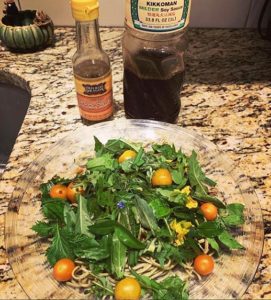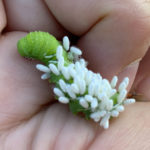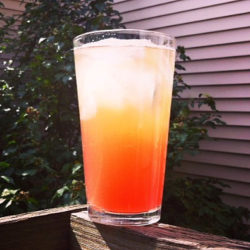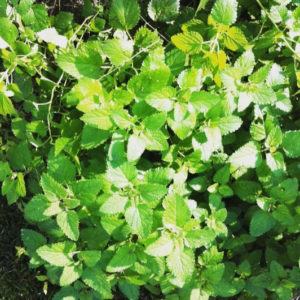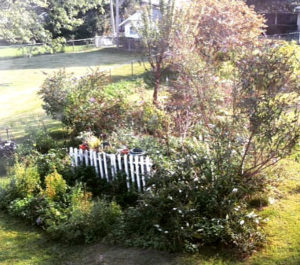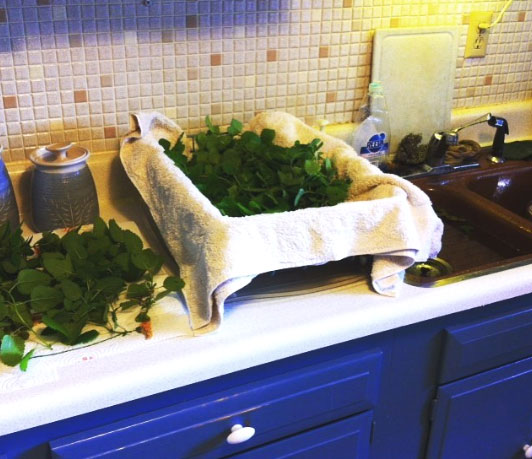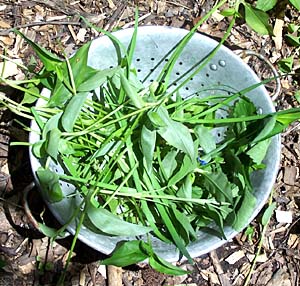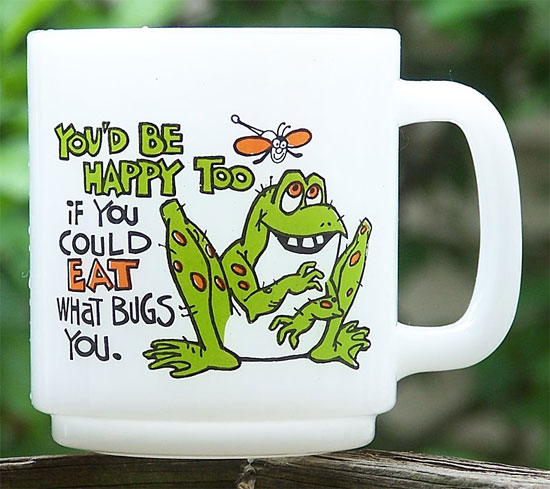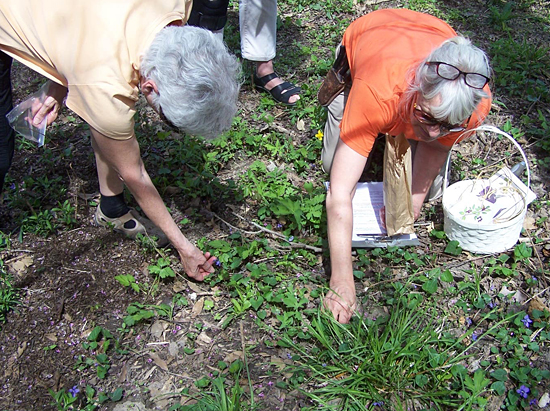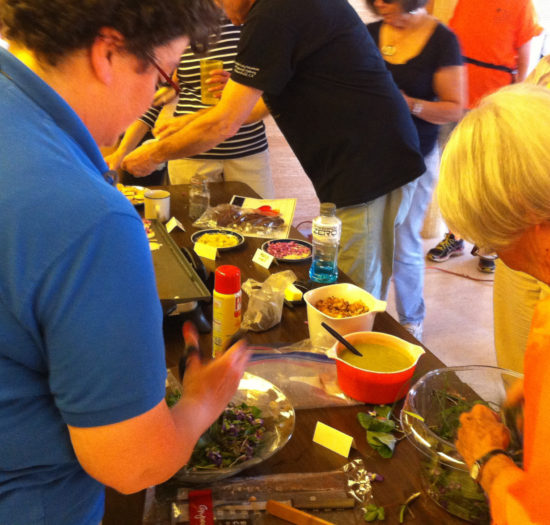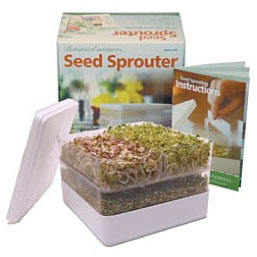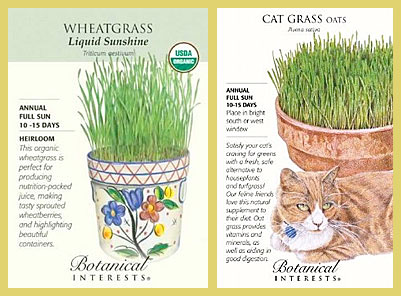Collards Taste Great in Quiche
by Carolyn Hasenfratz Winkelmann
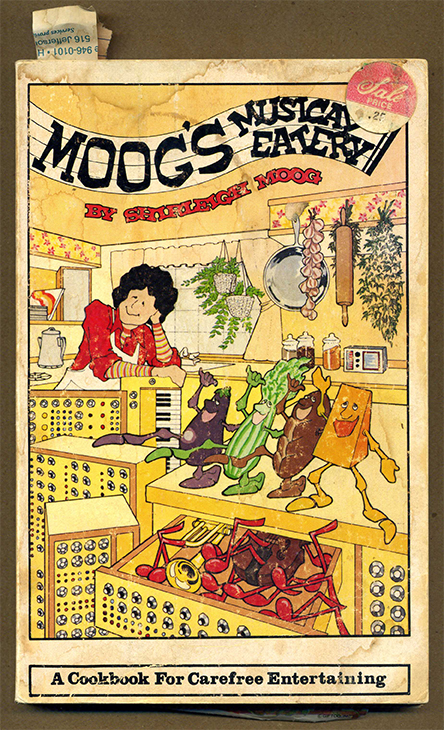
My Mom was a prize-winning cook and I grew up in a house with an extensive cookbook and recipe collection. “Moog’s Musical Eatery”, the cookbook pictured at the right, was the first cookbook I remember purchasing for myself. I found it at the college bookstore and by then it had been on the shelf long enough to be on sale for $0.25. The main reason I bought it was to get-delicious sounding recipes for a low price. It was an even better deal than I knew because upon reading it I learned that it has a lot of good tips on entertaining, menu planning and getting the most out of ingredients by learning how to choose and evaluate them. The author, Shirleigh Moog, wrote the book based on entertaining the friends and colleagues of herself and her husband, who was the inventor of the Moog synthesizer. First published in 1978 and purchased by me in the second half of the 1980s, it was one of my first introductions to some flavors that are well-known now in our culture but fairly exotic at the time, such as Tahini, Sangria, or Gazpacho. This book has been out of print a long time but there are still a few pre-owned copies available for sale online. My copy is well-used as you can see!
The recipe in this book that I have probably made the most times is the Onion Quiche. I have varied the filling ingredients a lot over the years and have never found a reason to look for another base quiche recipe. Currently I have an abundance of collards coming from my garden. A couple of times this summer I included them as one of my Quiche ingredients with wonderful results. First I’m going to describe how I harvest and cook the collards to get them ready to use as Quiche filling, then I’m going to provide Shirleigh Moog’s Quiche recipe with added notations where I normally change things up. Moog’s version included a crust recipe that I’m not going to post here because I’ve always used pre-made crusts to save time and I don’t think I’ve ever made it with scratch crust.
Harvesting and Preparing the Collards
Before I go out to harvest collards or any kind of greens, I get out a large lightweight bowl that I use as my collecting bowl. I keep a container of homemade broth in the freezer to use when I want to simmer something in broth, cook rice or grains with broth, make soup, or something of that nature. I needed a half cup or so of broth to simmer the greens in, so I set my broth container out to thaw while I worked on other preparations.
When I fill the bowl with produce from the garden, I get a colander ready for draining. I let the bowl with produce fill with water as I clean and shake off the leaves before transferring to the colander to drain. Since I’m an organic gardener and don’t use pesticides, there are sometimes a few “bugs” on the leaves. Letting the leaves soak as I clean and inspect makes most invertebrates, if there are any, float out for easy removal. If they are pests, I feed them to my pet starlings who are always eager to consume such a nutritious tidbit. If they are beneficial insects, I put them back outside. I only found one “bug” in this bowl so that was not bad.
Right below one of the ribs on the underside of this collard leaf was a little green caterpillar. When you harvest leafy greens like this be sure to look at the underside and look for caterpillars near the leaf ribs or stems. They like to tuck themselves there to blend in and avoid predators. Some of them are very good at disguising themselves as another stem or rib!
If any parts of the leaves are yellowed or too chewed up, I put those parts in the compost bin. I cut out any thick stems that might be too tough and compost them also.
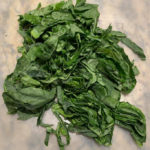 When the leaves are cleaned and drained, I roll them tightly into a quasi-cylinder shape and diagonally slice them thinly. This is called the chiffonade cut.
When the leaves are cleaned and drained, I roll them tightly into a quasi-cylinder shape and diagonally slice them thinly. This is called the chiffonade cut.
My husband requires a relatively low-salt diet and I’ve been cooking with minimal added salt for many years so that I become accustomed to less salt just in case! One way I get flavor into foods so that they don’t need added salt is to cook them in pan juices from something else. Even if I don’t plan to use meats in the recipe I’m about to make, I often like to add flavor and some salt by cooking things like ham, turkey bacon or turkey kielbasa (as shown here) in the pan first, with a little grapeseed oil or olive oil. Processed and cured meats will have some salt in them but cooking and caramelizing some of these ingredients adds enough flavor that it’s usually plenty of salt for the whole recipe.
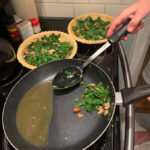 I then set the meat aside then cook some onions in the pan juices until they are caramelized. Any onions I have on hand I’ll use, but it’s hard to beat sweet yellow onions. I set the onions aside then cook the collards in what pan juices are left over plus a little broth to simmer them in and keep them from burning. At this point I have pre-heated the oven and am filling the pie shells with the cooked collards, also adding in some of the cooked turkey kielbasa and onions. As you can see there are some delicious pan juices left over. The pan juices were strained out and added to my broth bowl for other uses. Too many juices in the quiches might make them watery.
I then set the meat aside then cook some onions in the pan juices until they are caramelized. Any onions I have on hand I’ll use, but it’s hard to beat sweet yellow onions. I set the onions aside then cook the collards in what pan juices are left over plus a little broth to simmer them in and keep them from burning. At this point I have pre-heated the oven and am filling the pie shells with the cooked collards, also adding in some of the cooked turkey kielbasa and onions. As you can see there are some delicious pan juices left over. The pan juices were strained out and added to my broth bowl for other uses. Too many juices in the quiches might make them watery.
You will notice that the recipe from Shirleigh Moog that I’m going to reproduce here was originally written to make one quiche. I have found that if I loosely fill two pie shells to the top with vegetables and meat tidbits, the recipe makes two quiches from two pre-made shells.
Onion Quiche
From “Moog’s Musical Eatery”, page 88. Copyright 1978 by Shirleigh Moog. My additional notes are in italics.
6 slices bacon (as noted above, sometimes I substitute ham, turkey bacon, or turkey kielbasa.)
3 onions, sliced thin
4 eggs
1 tall can evaporated milk (1 2/3 cups) or heavy cream
2/3 cup water (I have substituted my homemade broth also with great results)
3/4 t salt (I rarely need this)
1 t dry mustard
a dash of Tabasco sauce
1/2 t Hungarian paprika (smoked paprika good too)
1 t soy sauce
1 cup grated cheddar cheese
1 clove garlic, minced (If I’m putting in garlic, I cook it at the stage where I cook the collards with broth so that the garlic pieces don’t burn, I find them too bitter if burned)
1 9″ pie shell (as noted above, I use 2 pre-made pie shells because I normally add vegetables, such as collards, spinach, broccoli, mushrooms, bell pepper, dandelion greens, etc.)
- Cook the bacon and, when there is plenty of bacon fat in the pan, add the onion and garlic. Cook until the bacon is done and the onions are golden. Crumble the bacon.
- Combine the eggs, evaporated milk, water, salt, dry mustard, soy sauce, Tabasco and paprika. Beat with a rotary beater just long enough to mix thoroughly. (I normally just use a whisk with good results.)
- Sprinkle the pie shell with the crumbled bacon, the onion, garlic, Cheddar cheese and any remaining bacon grease. Sauteed mushrooms and bits of ham may also be added. Pour the egg and milk mixture in also.
- Bake in a preheated oven at 325 degrees F for one hour, or until the point of a knife inserted in the center of the quiche comes out clean. (I like to put the pie shells on old baking pans to prevent bubbling over, which normally does not happen. The baking time and temperature Moog suggests is spot on – I like to set the alarm for 45 minutes, check just in case, put back in, and the knife comes out clean at the one hour mark with the crust perfectly golden and flaky. I would hate to burn it or undercook it though, so I do the 45 minute test each time as a precaution.)
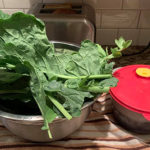
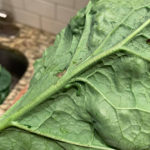

 I’ve been having really good luck again with cherry tomatoes and I’m now addicted to growing leafy green vegetables so I can have fresh tasty salads that I pick myself. A few of the plants have really been chewed on by pests which is not a surprise because I don’t use pesticides. In my haste I made no effort to try
I’ve been having really good luck again with cherry tomatoes and I’m now addicted to growing leafy green vegetables so I can have fresh tasty salads that I pick myself. A few of the plants have really been chewed on by pests which is not a surprise because I don’t use pesticides. In my haste I made no effort to try 